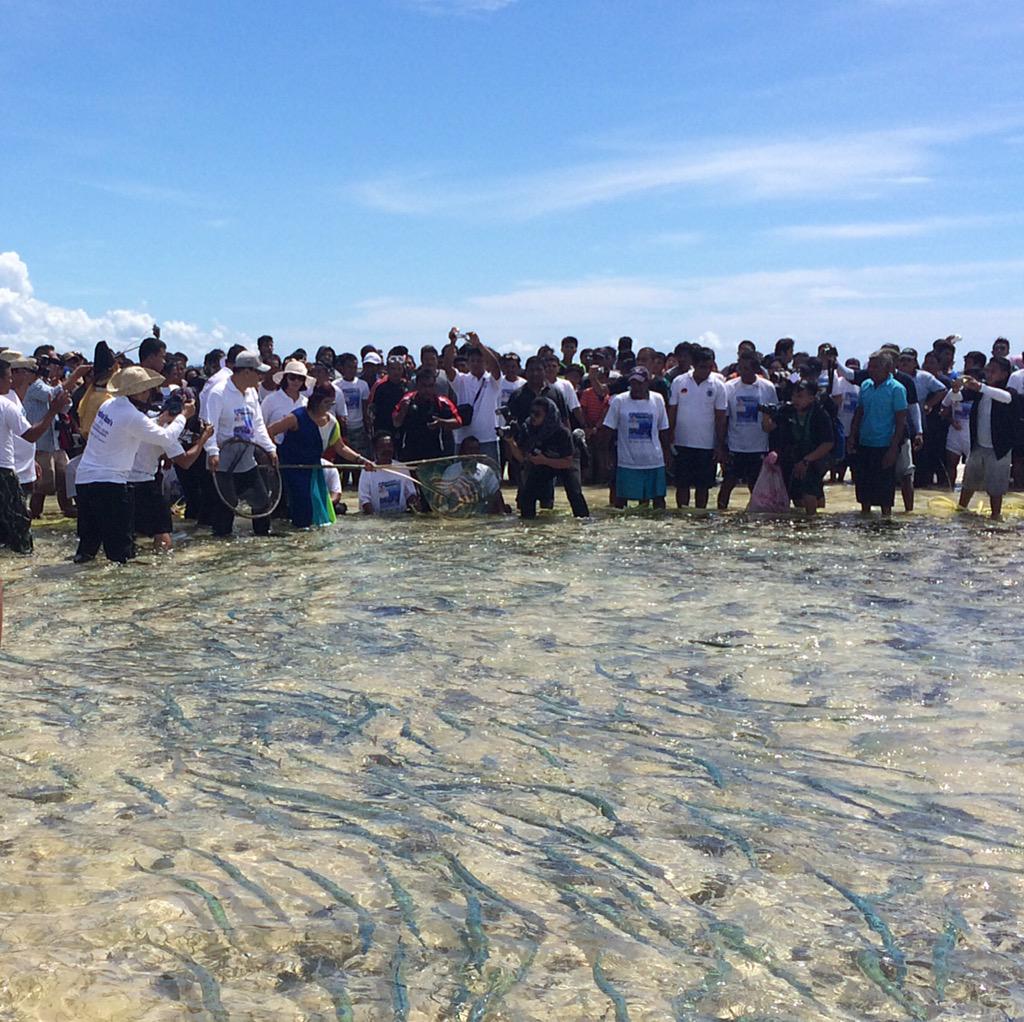Kakorotan is archipelago that includes the island: Kakorotan, Intata, and Malo. Administratively, the islands included in the Talaud Islands, North Sulawesi. In the area of small islands located in the northern end of Indonesia's since the 16th century there was a traditional ceremony called mane'e which means "take the fish in the sea together after deliberation".
Tradition of fishing in congregation are performed by 10 ethnic groups in the region Kakorotan, the end of the EHA. EHA is the prohibition period to take marine products (fish) and terrestrial (fruits, vegetables, livestock) for three to six months each year. During the time of the EHA, no matter what a citizen should take the natural resources on land and sea in a specific zone in the region Kakorotan. If there are people who caught a foul, then the penalty is a fine in the amount Rp.100.00,00 multiples, or depending on the number of people who caught plus two traditional elders and the leaders of each ethnic people that were there.
Time, place, and Parties Involved in Ceremony
Such ceremonies in general, mane'e ceremony was also carried out gradually. There are four stages to go through in this ceremony, namely: (1) phase pundagi maraca or cut the forest rope held three days before the ritual mane'e held; (2) the stage of salvation prayer led by the traditional elders (mangolom para) Kakorotan Island; (3) the stage of determining the time and zone Intata ceremony on the island (about 600 meters north of the island Kakorotan). The timing is based on the position of the moon that will affect the ebb and flow of sea water; and (4) the stage mane'e or catch fish in a gang on the waterfront. Meanwhile, the parties involved in the ceremony mane'e is indigenous elders, community leaders, community residents Kakorotan Islands, and some residents outside Kakorotan Islands which received an invitation or want to watch the ceremony.
Ceremony Equipment
Fixtures that need to be prepared in this mane'e ceremony were: (1) jubih (arrow sea), (2) filter; and (3) rectangular nets made of palm leaf and forest ropes. These nets are made cooperate by all citizens Karorotan that can reach three kilometers in length.
The road Ceremony
After the EHA end, the traditional elders in the islands Kakorotan began to preach to the citizens that they are getting ready to throw a party mane'e both on land and at sea on a large scale. The news was then relayed by residents on other residents who are being migrated or are outside the territory Kakorotan.
At the time the head of customs conduct these deliberations Kakorotan Island residents began to knit webs of material palm leaf and forest ropes. After the nets are ready, the morning before the ceremony leaf nets are brought in a gang to spread (Mamoto u'sammi) to the ocean that is pairs. Before installing the nets, they make a kind of puddle of 400 square meters that will be used to trap fish when the sea water was receding.
When all participants of the ceremony had been on the beach, before noon nets that have been installed are then pulled to the shore while directing the fish into a puddle on the shoreline. Of driving the fish into a puddle that takes about four to five hours. And, if the fish had been collected in puddles, residents were immediately menangkapinya by using jubih (arrows sea), filter or with bare hands. Fish catches it and then there is the take home and some are distributed to visitors or tourists to be burned and eaten together. Mane'e ritual ends with a prayer together as a gratitude to God (manarimma alama).
Cultural Values
Mane'e ceremony in the community on the islands Kakorotan, if examined in depth, contains values that in turn can be used as a reference in everyday life. Those values are: solidarity, mutual aid, and religious wisdom. Common values reflected in the gathering of most members of the public in a place to be equally followed the procession mane'e and then pray together for the sake of safety along anyway. It is a form of togetherness in life together in their environment (in the broad sense). Therefore, this ceremony contains the value of togetherness. In this case, togetherness as a community that has a territory, customs and culture of the same.


Cooperativeness value reflected in the involvement of various parties in the implementation of the ceremony. They help each other for the implementation of the ceremony. In this case there is help prepare material for the net, making the net, making puddles on the beach and so forth.
Value wisdom reflected mane'e ceremony itself is a series of end of period EHA or banning retrieval of existing resources in the sea and on land. The function of this prohibition is basically to keep the natural resources remain sustainable and can be enjoyed by future generations.
Religious values reflected in the common prayer addressed to God in order to get protection, the safety and well-being in life.




Comments
Post a Comment
If you like this article, give me your appreciation on this comment box and click share button via social media.